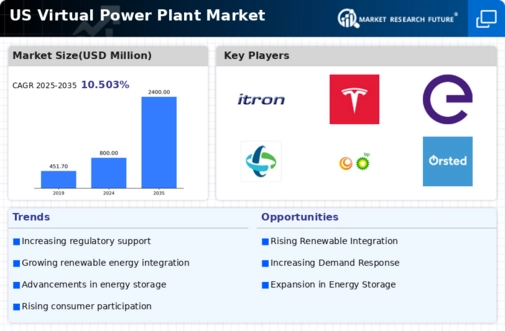Growing Demand for Energy Resilience
The growing demand for energy resilience is emerging as a critical driver in the virtual power-plant market. As extreme weather events and other disruptions become more frequent, the need for reliable energy sources intensifies. Virtual power plants offer a solution by providing backup power and enhancing grid resilience. In 2025, it is estimated that the market for energy resilience solutions will reach $3 billion in the US. This trend suggests that consumers and businesses are increasingly prioritizing energy security, thereby driving the adoption of virtual power plants as a viable alternative to traditional energy sources.
Integration of Renewable Energy Sources
The integration of renewable energy sources into the virtual power-plant market appears to be a pivotal driver. As the demand for clean energy escalates, the virtual power-plant market facilitates the aggregation of distributed energy resources, such as solar and wind. This integration not only enhances grid reliability but also supports the transition towards a low-carbon economy. In 2025, renewable energy accounted for approximately 20% of the total electricity generation in the US, indicating a growing trend. The virtual power-plant market plays a crucial role in optimizing the use of these resources, thereby contributing to energy efficiency and sustainability.
Advancements in Energy Management Systems
Advancements in energy management systems are likely to propel the virtual power-plant market forward. These systems enable real-time monitoring and control of energy consumption, which is essential for optimizing the performance of virtual power plants. The increasing sophistication of these technologies allows for better demand response strategies, enhancing grid stability. In 2025, the market for energy management systems in the US is projected to reach $5 billion, reflecting a robust growth trajectory. This growth underscores the importance of effective energy management in the virtual power-plant market, as it directly influences operational efficiency and cost savings.
Increased Investment in Smart Grid Technologies
Increased investment in smart grid technologies is a significant driver for the virtual power-plant market. Smart grids facilitate improved communication between energy producers and consumers, enabling more efficient energy distribution. The US government has allocated substantial funding towards smart grid initiatives, with investments exceeding $7 billion in recent years. This financial commitment indicates a strong belief in the potential of smart grids to enhance the functionality of virtual power plants. As these technologies evolve, they are expected to create new opportunities for energy management and optimization within the virtual power-plant market.
Consumer Awareness and Adoption of Distributed Energy Resources
Consumer awareness and adoption of distributed energy resources are likely to influence the virtual power-plant market significantly. As individuals and businesses become more informed about the benefits of solar panels, battery storage, and other distributed resources, the demand for virtual power plants increases. In 2025, it is projected that residential solar installations will grow by 15%, reflecting a shift towards decentralized energy solutions. This trend indicates that consumers are actively seeking ways to participate in energy generation, thereby enhancing the role of virtual power plants in the overall energy landscape.

















Leave a Comment